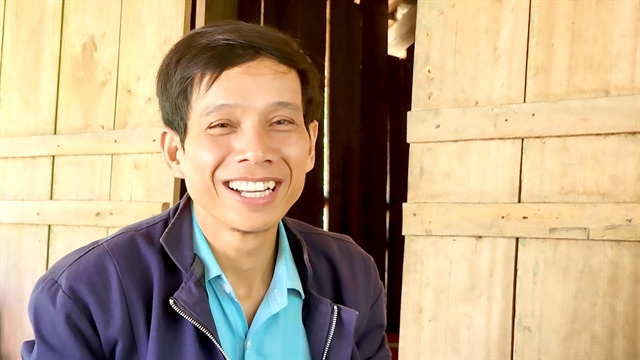 Society
Society

 |
| Phạm Văn Đếch is glad that Rêu Village has changed for the better. Photo tienphong.vn |
QUẢNG NGÃI - After more than a decade of being besieged by a mysterious illness, Rêu Village, located in the mountainous region of Ba Điền Commune, Ba Tơ District, central Quảng Ngãi Province is now peaceful, and the lives of its residents are improving.
Sturdy houses have sprung up, the roads leading to the village have been paved with concrete, and lush green paddy fields have replaced abandoned ones. Painful memories still linger, but the transformation is evident.
Over 12 years ago, Rêu Village was struck by a sinister disease known as the "mysterious illness," which claimed the lives of dozens of its inhabitants.
Fear and anxiety were constant companions to the villagers as new cases continued to emerge daily, leading to deaths, people abandoning the village, children dropping out of school, and fields lying fallow.
In just three years, from 2011 to 2014, 264 people in Ba Điền commune suffered from a rare skin condition affecting their palms and soles, with 24 fatalities. This affliction was particularly concentrated in Rêu Village.
Time has passed, and the pain has slowly receded, but every mention of the "mysterious illness" still causes anguish to Phạm Văn Đếch, a culture officer in Ba Điền commune. This disease took away two loved ones, his wife and young child, and marked the beginning of a dark chapter for Rêu Village.
Đếch recalls that in October 2010, his healthy three-year-old child suddenly developed swollen, ulcerated skin on the face and limbs.
He immediately rushed the child to the district's health facility, but after three to four days, they were transferred to Đà Nẵng. Even in Đà Nẵng, the doctors couldn't diagnose the disease, and it eventually claimed the life of his child.
The nightmare continued as by the end of 2011, his wife displayed similar symptoms - facial swelling and ulceration on her hands and feet. Đếch took his wife to Quy Nhơn and even Huế for treatment, but the doctors were unable to identify the cause.
In early 2012, his wife passed away, leaving Đếch as the sole survivor in his family, and he himself was afflicted but fortunately recovered, unlike his wife and child.
"By the end of 2011, my wife started showing signs of facial swelling and skin ulcers. We took her to Quy Nhơn, then Huế for treatment, but even the doctors there couldn't identify the disease. She passed away in early 2012. I also contracted the disease, but I was lucky to recover, while my wife and child followed Yàng (God)," Đếch told Tiền Phong (Vanguard) newspaper.
Subsequently, numerous medical experts, both local and international, including teams from the provincial health department, the Ministry of Health, and the World Health Organization (WHO), arrived to investigate, gather data, and collect samples of water, soil, food, blood, and hair from the patients. The goal was to understand the causes of the disease and develop treatment methods.
 |
| Phạm Thị Xao recounts the lingering effects of the "mysterious illness." Photo tienphong.vn |
Nonetheless, deaths continued to afflict the villagers, challenging the healthcare system. Some families, with three or four members suffering from this disease, saw their death toll rise steadily.
Desperate to find a cure, the villagers resorted to sacrificial rituals, including slaughtering chickens and pigs, and performing ceremonies in the mountains to ward off the "ghostly disease." Yet, despite the offerings, the villagers remained afflicted. Even the village's shamans were so frightened that they left, leaving the people to fend for themselves.
Rêu Village is home to 103 households with nearly 300 residents, primarily from the Hrê ethnic group, who make up 98 per cent of the population. With the help of various levels of government and different departments, the villagers rallied to rebuild their lives. They focused on cultivating rice, planting rubber trees, and developing livestock farming. As a result, no household in the village suffers from food shortages as they did in the past, many have seen an improvement in their economic situation, and they have built more comfortable homes.
Finally, thanks to the tireless efforts of medical experts, both local and international, the mystery behind the "mysterious illness" was gradually solved, bringing peace back to this village nestled among the hills.
Transformation
When visitors come to Rêu Village, they are greeted with a serene and idyllic landscape - lush, vibrant paddy fields, a well-paved road leading to the village, and a sense of tranquility in the air. It's hard to believe that this village once experienced the hardship and suffering caused by the "mysterious illness."
Phạm Văn Đếch pointed out that a suspension bridge spanning Nước Nẻ Stream was constructed and put into use in early 2016. The day of its inauguration was a day of celebration, as it meant that the villagers were no longer at the mercy of the stream's swelling waters during the rainy season.
Taking us on a tour of the village, Đếch proudly highlighted the transformation: the previously gravel road leading into the village has been replaced with a concrete one, and many public works and cultural facilities have been built, improving the residents' quality of life. Electricity now lights up the streets and alleyways.
However, the most significant change is in the mindset and lifestyle of the villagers. "Thanks to the involvement of local authorities and the healthcare sector, the people of Rêu Village came to understand that there was no 'ghost' causing the illness. It was primarily due to their difficult lives, outdated eating habits, and limited access to healthcare," explains Phạm Thị Ửi, a 43-year-old resident of Rêu Village.
"New ways of thinking and doing things have brought Rêu Village closer to modern living. People no longer keep livestock beneath their stilt houses; each family has its own livestock pens. Practices like storing food above smoky fires or leaving rice in thatched huts, leading to moisture and mold, are no longer common. The villagers have learned how to preserve their crops after harvesting and the importance of visiting the health station when they're unwell. It's a new way of life," Đếch says.
Alongside other village residents who have endured the loss of loved ones, Đếch has worked diligently to build a new life. He now has a new family with a preschool teacher from the local area, and they have two young children together.
Lingering Concerns
The disease may be a thing of the past, but those who once suffered from it in Rêu Village are now concerned about its lingering effects, such as vision and hearing impairment. Despite having been cured of the disease for several years, some individuals are still grappling with these post-illness complications.
Phạm Thị Xao, a 67-year-old, is among those who have experienced these complications. She has partial hearing loss and says, "a few years ago, I went to the provincial hospital for an examination and treatment, but my condition did not improve."
The disease has also affected her daughter-in-law, Phạm Thị Triêu, who has suffered from vision problems. Despite seeking treatment from various places, her condition has not improved. Đếch, too, has experienced vision problems, which he believes are a consequence of the disease he once battled.
Phạm Văn Ênh, Deputy Chairman of the People's Committee of Ba Điền commune, confirms that the majority of individuals who were treated for the skin condition, which affected their palms and soles, are now grappling with complications such as vision and hearing impairment, to varying degrees of severity. Approximately ten cases face severe complications and are currently receiving treatment in various hospitals.
"Local authorities, as well as the residents of Rêu Village, hope that the relevant authorities, at all levels, will pay attention to their request. They are urging the Ministry of Health and related agencies to visit the locality, conduct examinations and assessments, and provide comprehensive treatment for the complications of this disease. This would bring much-needed peace of mind to the people," Ênh states. VNS




